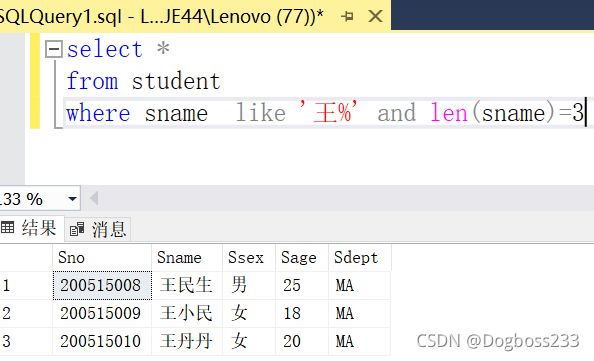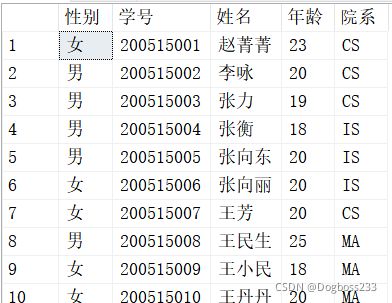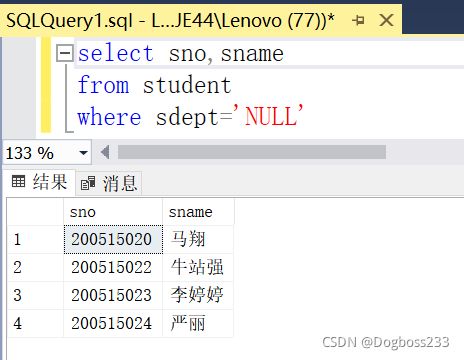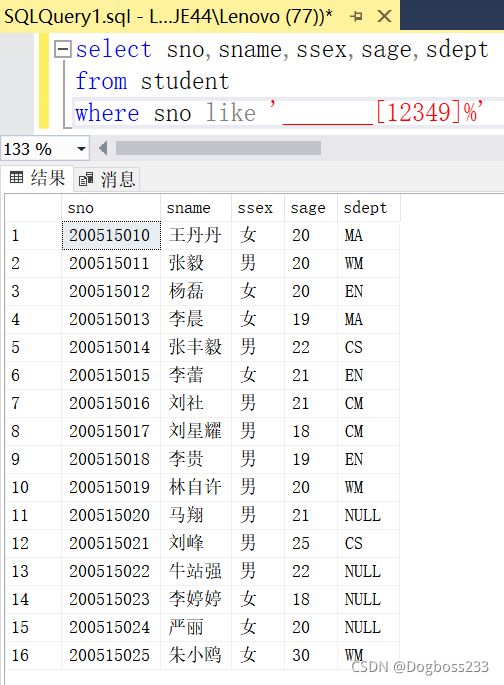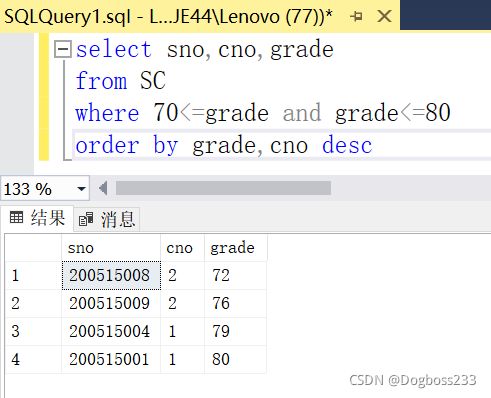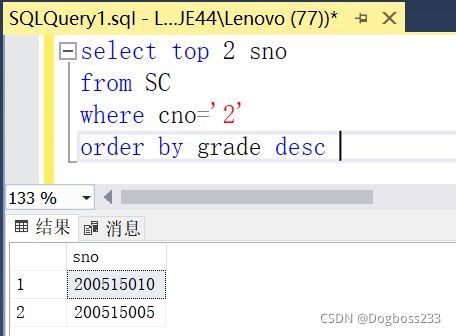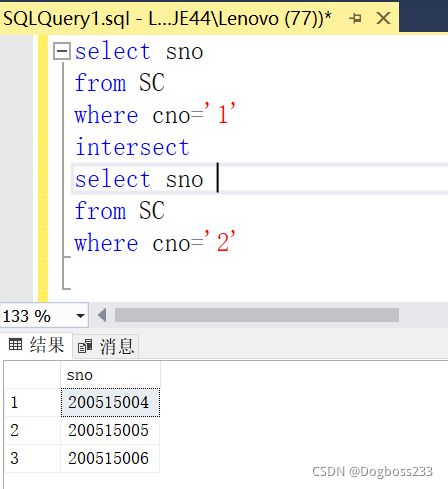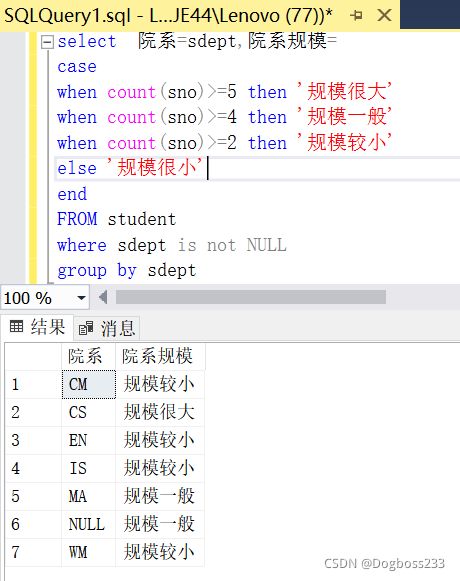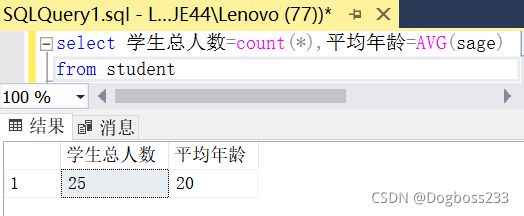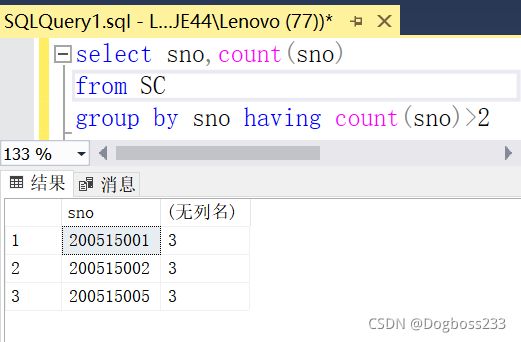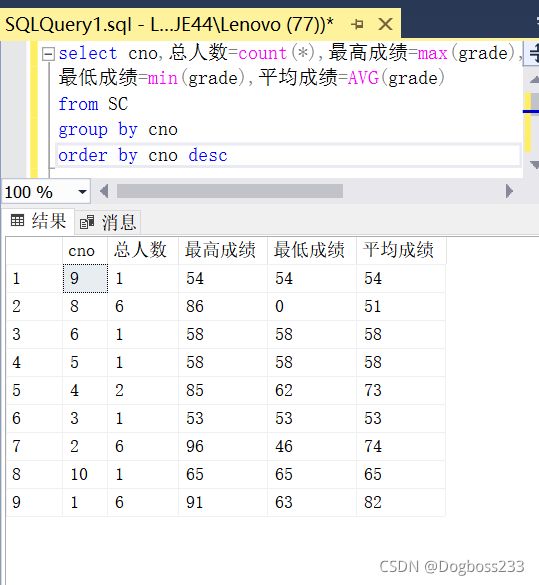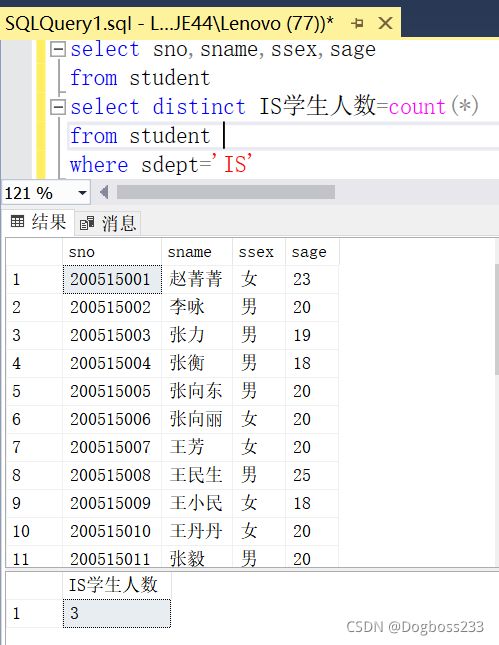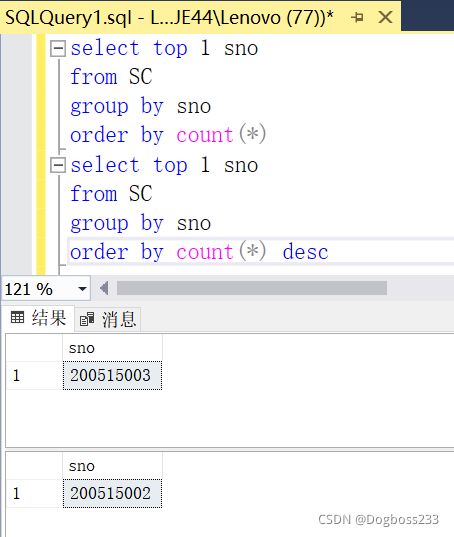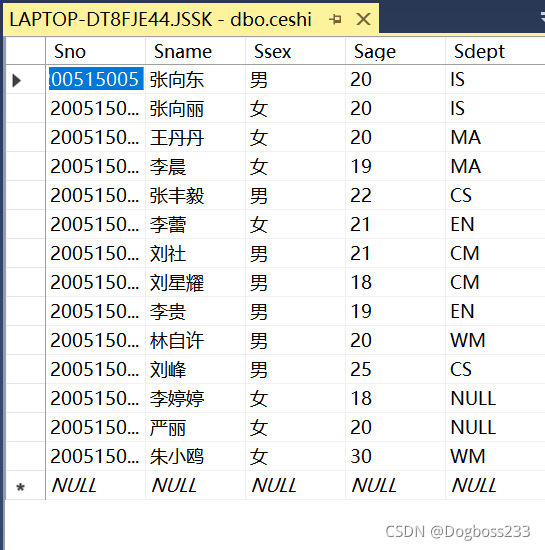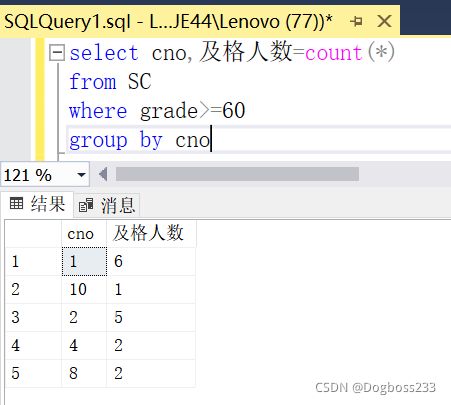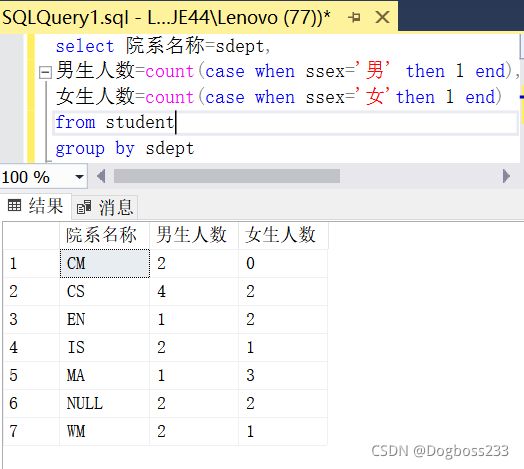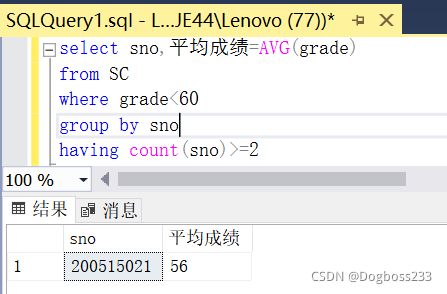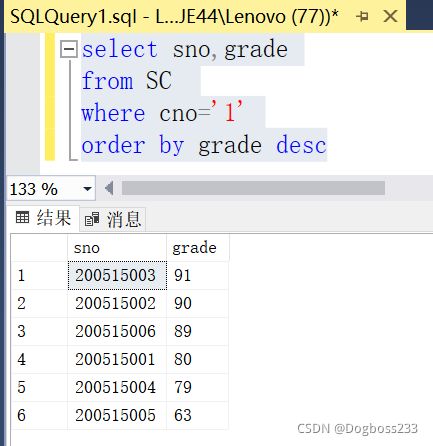数据库系统概论实验五——数据库单表查询
一、实验目的
- 掌握SELECT语句的基本语法和查询条件表示方法;
- 掌握查询条件表达式和使用方法;
- 掌握GROUP BY 子句的作用和使用方法;
- 掌握HAVING子句的作用和使用方法;
- 掌握ORDER BY子句的作用和使用方法。
二、实验学时
2学时
三、实验要求
- 熟练数据库查询语句;
- 掌握数据库查询的实现方式;
- 完成实验报告;
四、实验内容
以SQL实验4数据库中数据为基础,请使用T-SQL 语句实现以下操作:
1.列出所有不姓“张”的所有学生的基本信息;
select *
from student
where sname not like '张%'
2.列出姓“王”且全名为3个汉字的学生的基本信息;
select *
from student
where sname like '王%' and len(sname)=3
3.显示在1986年以后出生的学生的学号和姓名;
select sno,sname
from student
where 2021-sage>1986
4.按照“性别、学号、姓名、年龄、院系”的顺序列出学生信息,并重新命名各列;
select ssex 性别,sno 学号,sname 姓名,sage 年龄,sdept 院系
from student
5.查询没有分配院系的学生的姓名和学号;
select sno,sname
from student
where sdept='NULL'
6.显示学号第八位或者第九位是1、2、3、4或者9的学生的学号、姓名、性别、年龄及院系;
select sno,sname,ssex,sage,sdept
from student
where sno like '_______[12349]%'
7.列出选修了01号课程的学生的学号和成绩,按成绩的降序排列;
select sno,grade
from SC
where cno='1'
order by grade desc

8.按照课程号、成绩降序显示课程成绩在70-80之间的学生的学号、课程号及成绩;
```sql
select sno,cno,grade
from SC
where 70<=grade and grade<=80
order by grade,cno desc
9.按照院系降序显示所有学生的 “院系,学号、姓名、性别、年龄”等信息,其中院系按照以下规定显示:院系为CS显示为计算机系,院系为IS显示为信息系,院系为MA显示为数学系,院系为EN显示为外语系,院系为CM显示为中医系,院系为WM显示为西医系,其他显示为院系不明;
SELECT 院系=
case
when sdept='CS' then '计算机系'
when sdept='IS' then '信息系'
when sdept='MA' then '数学系'
when sdept='EN' then '外语系'
when sdept='CM' then '中医系'
when sdept='WM' then '西医系'
else '院系不明'
end,sno 学号,sname as 姓名,ssex as 性别,sage as 年龄
FROM student
ORDER BY 院系 desc
10.显示选修02号课程的成绩前两名的学生学号。
select top 2 sno
from SC
where cno='2'
order by grade desc
11.列出同时选修“1”号课程和“2”号课程的所有学生的学号;
方法一:
select sno
from SC
where cno='1'
Intersect
select sno
from SC
where cno='2'
方法二:
select sno
from SC
where cno='1'
and sno in(select sno
from SC
where cno='2')
12.显示所有院系(要求不能重复,不包括空值),并在结果集中增加一列字段“院系规模”,其中若该院系人数>=5则该字段值为“规模很大”,若该院系人数大于等于4小于5则该字段值为“规模一般”, 若该院系人数大于等于2小于4则该字段值为“规模稍小”,否则显示“规模很小”;
select 院系=sdept,院系规模=
case
when count(sno)>=5 then '规模很大'
when count(sno)>=4 then '规模一般'
when count(sno)>=2 then '规模较小'
else '规模很小'
end
FROM student
where sdept is not NULL
group by sdept
13.显示学生信息表中的学生总人数及平均年龄,在结果集中列标题分别指定为“学生总人数,平均年龄”;
select 学生总人数=count(*),平均年龄=AVG(sage)
from student
14.显示选修的课程数大于2的各个学生的选修课程数;
select sno,count(sno)
from SC
group by sno having count(sno)>2
15.按课程号降序显示选修各个课程的总人数、最高成绩、最低成绩及平均成绩;
select cno,总人数=count(*),最高成绩=max(grade),
最低成绩=min(grade),平均成绩=AVG(grade)
from SC
group by cno
order by cno desc
16.显示平均成绩大于“赵菁菁”平均成绩的各个学生的学号、平均成绩;
select sno,平均成绩=AVG(grade)
from SC
group by sno
having AVG(grade)>(select AVG(grade)
from SC,student
where sname='赵菁菁')
order by AVG(grade) desc
17.显示IS系学生的学号、姓名、性别、年龄,并统计出IS系的学生个数;
select sno,sname,ssex,sage
from student
select distinct IS学生人数=count(*)
from student
where sdept='IS'
18.显示选修课程数最多的学号及选修课程数最少的学号;
select top 1 sno
from SC
group by sno
order by count(*)
select top 1 sno
from SC
group by sno
order by count(*) desc
19.显示每个院系的学生前两条记录,并组成新表ceshi;
select student.* into ceshi
from student
where sno in (select top 2 sno
from student
where sdept=student.sdept
order by sdept desc)
20.*显示选修各个课程的及格的人数;
select cno,及格人数=count(*)
from SC
where grade>=60
group by cno
21.*显示各个院系男女生人数,其中在结果集中列标题分别指定为“院系名称、男生人数、女生人数”;
select 院系名称=sdept,
男生人数=count(case when ssex='男' then 1 end),
女生人数=count(case when ssex='女'then 1 end)
from student
group by sdept
22.*列出有二门以上课程(含两门)不及格的学生的学号及该学生的平均成绩;
select sno,平均成绩=AVG(grade)
from SC
where grade<60
group by sno
having count(sno)>=2
注:需要在实验报告册中写出每道题的T-SQL语句。
五、实验步骤
命令方式:在【SQL Server Management Studio】窗口左上方选择【新建查询】按钮,启动SQL编辑器窗口,在光标处输入T-SQL语句,单击【执行】按钮。例如第一题可输入:
select * from student where sname not like ‘刘%’

